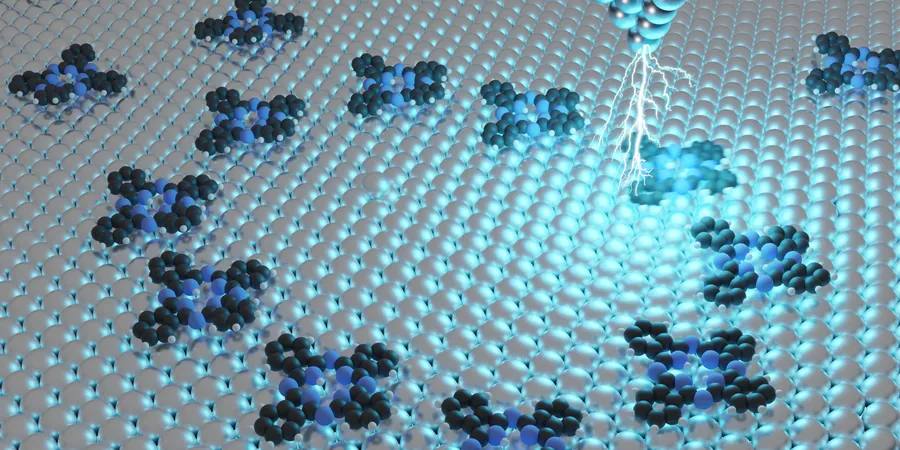
Revolutionizing Nanostructure Design with Autonomous AI Assistants: A Leap into the Future!
2025-01-16
Author: Yu
The world of materials science is on the brink of a transformative breakthrough thanks to an ambitious research project at TU Graz. Researchers are harnessing the power of artificial intelligence to advance the construction of nanostructures—an essential undertaking that goes beyond merely analyzing a material's chemical composition.
While the chemical makeup of a substance is crucial, it is often the arrangement of molecules within its atomic lattice or surface that determines its unique properties. Currently, materials scientists utilize high-performance microscopes to painstakingly apply individual atoms and molecules to surfaces. This process is not only labor-intensive but also limits the complexity of the resulting nanostructures.
Enter the innovative research group led by Oliver Hofmann from the Institute of Solid State Physics, who aims to elevate the construction of these nanoscale structures by developing a self-learning AI assistant. Their groundbreaking findings have been featured in the journal Computer Physics Communications. Hofmann asserts, "Our goal is to design an AI system capable of autonomously positioning molecules with unparalleled speed, specificity, and accuracy, paving the way for the creation of sophisticated molecular architectures, including nanoscale logic circuits."
The Game-Changer: A Scanning Tunneling Microscope Powered by AI
At the heart of this endeavor is the scanning tunneling microscope (STM), which enables the precise placement of molecules on a material's surface through electrical impulses emitted from its probe tip. While a human operator may take minutes to position even a simple molecule, the need for complexity in molecular structures has made this approach impractical for advanced applications. To address this, Hofmann's team is integrating machine learning techniques to create an AI-driven system that can execute these tasks independently.
Initially, AI algorithms will devise an optimal blueprint for constructing nanostructures efficiently. Once this plan is established, self-learning algorithms will take control, guiding the probe tip to position molecules with exceptional precision. As Hofmann elaborates, "Precision placement of complex molecules could be challenging due to the inherent randomness present, despite using advanced control methods." To tackle this problem, the researchers will incorporate probability factors into the AI's decision-making processes, ensuring reliability in outcomes.
Quantum Corrals: The Future of Nanotechnology?
One of the most promising applications of this advanced AI-controlled STM is the creation of "quantum corrals"—nanostructures designed to trap electrons. These corrals can exploit the wave-like properties of electrons, leading to quantum-mechanical interferences that have a range of potential practical applications.
Traditionally, quantum corrals have been fabricated from single atoms. Hofmann's team theorizes that by leveraging more complex molecular shapes, they will be able to produce an array of diverse quantum corrals, significantly enhancing their functional capabilities. The team's ultimate ambition is to utilize these advanced structures to craft intricate logic circuits, allowing for an in-depth exploration of their molecular-level operations.
Could we be on the cusp of using quantum corrals for revolutionary applications like the next generation of computer chips? The future looks promising, and with AI leading the charge, the landscape of nanotechnology may soon be unrecognizable. Stay tuned, as the implications of this research extend far beyond academic curiosity—they may hold the keys to our technological evolution!




 Brasil (PT)
Brasil (PT)
 Canada (EN)
Canada (EN)
 Chile (ES)
Chile (ES)
 Česko (CS)
Česko (CS)
 대한민국 (KO)
대한민국 (KO)
 España (ES)
España (ES)
 France (FR)
France (FR)
 Hong Kong (EN)
Hong Kong (EN)
 Italia (IT)
Italia (IT)
 日本 (JA)
日本 (JA)
 Magyarország (HU)
Magyarország (HU)
 Norge (NO)
Norge (NO)
 Polska (PL)
Polska (PL)
 Schweiz (DE)
Schweiz (DE)
 Singapore (EN)
Singapore (EN)
 Sverige (SV)
Sverige (SV)
 Suomi (FI)
Suomi (FI)
 Türkiye (TR)
Türkiye (TR)
 الإمارات العربية المتحدة (AR)
الإمارات العربية المتحدة (AR)